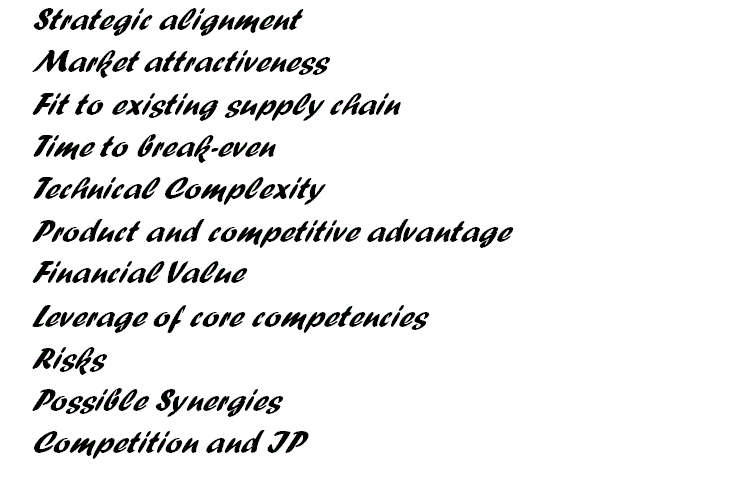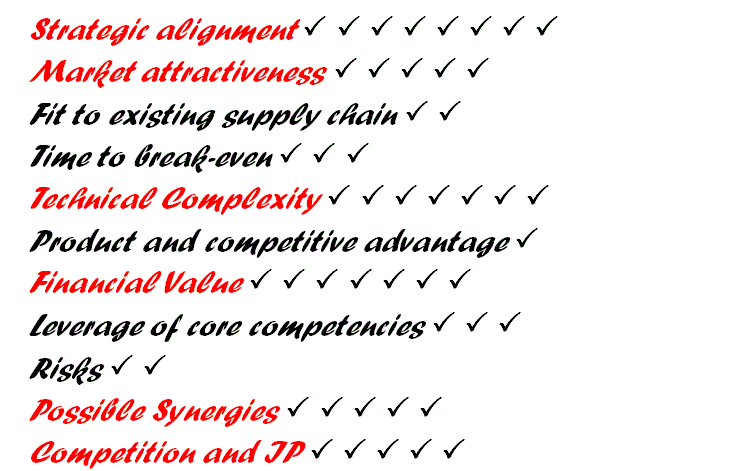Now that we have examined the pros and cons of the purely financial approach to portfolio let us turn our attention to a more balanced approach called the “scoring model”.
The essence of the scoring model approach is to come up with several variables that the executives consider important when assessing the value of their future projects. This is usually done during the project portfolio workshop where the instructor explains the theory behind the scoring approach, provides several examples of the scoring models developed by other companies and then asks the executives present to engage in a brainstorming exercise. The fundamental nature of this exercise is to generate as many relevant criteria as possible and record them on the whiteboard or a flipchart. These criteria may include, for example:
- Strategic alignment
- Market attractiveness
- Fit to existing supply chain
- Time to break-even
- NPV/ROI/IRR
- Product and competitive advantage
- Leverage of core competencies
- Technical Feasibility
- Risks, etc.
Once the discussion is over, the facilitator hands the red marker to the first person in the room and announces the following rules:
- Rule # 1: each participant “gets” three checkmarks
- Rule # 2: each participant must award all three checkmarks to the attributes listed on the board.
- Rule # 3: If the participant feels that just one of the attributes is of utmost importance, then he/she should award all three checkmarks to that attribute
- Rule # 4: if the participant feels that only two of the attributes are important (e.g. A and B), but, attribute A is more important than attribute B, then attribute A should get two checkmarks and attribute B - one checkmark.
- Rule # 5: if the participant thinks that any three of the attributes listed are important, then the checkmarks are equally distributed between three attributes.
- Rule # 6: Number of checkmarks per participant must equal three.
After the first person awarded his/her checkmarks, the red marker is passed on to the next person in the room until all the meeting participants have voted on the subject. The facilitator then counts checkmarks awarded to each attribute and the relative priorities are determined. Here is how it may look in real life: on one of my engagements a European product company executives came up with the following list of potentially important project attributes (see Figure 1).
Figure 1
After the “three point voting” has been completed the whiteboard looked like this (see Figure 2)
Figure 2
It is clear from the picture that strategic alignment, market attractiveness, technical complexity, financial value, possible synergies and competition and IP were deemed to be the most important factors. The next step is to determine boundaries for each criterion. It is very important to make these ranges as specific and measurable as possible and avoid terms like “Low”, “Medium”, “High”, “Weak”, “Strong”, etc.
Here is what the final scoring table looked like (see Table 1):
Table 1
|
1 point |
5 points |
15 points |
|
|
Strategic Fit |
Low Fits 1 of the criteria |
Medium Fits 2-3 of the criteria |
High Fits 4+ of the criteria |
|
Possible Synergies |
Low Can’t combine sales of proposed product with other product families |
Medium Can combine sales of proposed product with 1 other product family |
High Can combine sales of proposed product with 2+ other product family |
|
Financial Value |
Minor 0 < NPV <$1Mil |
Medium $1Mil < NPV < $5Mil |
Major NPV > $5Mil |
|
Technical Complexity |
Very Difficult A significant external expertise is required. |
Somewhat Difficult Will need some external expertise |
Easy Can be implemented by internal employees |
|
Market Attract |
Low Less than 10 requests |
Medium Between 11 and 30 requests |
Major More than 30 requests |
|
Competition and IP |
High Many competitors Weak IP protection |
Medium 3-4 competitors Normal IP protection |
Medium 0-2 competitors Strong IP protection |
NOTE: The strategic fit was dependent on the following four factors from the overall company strategy:
- New product families
- Attractive products
- Increase revenues and profitability
- Increase market share in the new markets
In that particular year the company project management office has calculated that they would have approximately 750 man-months in resources. Note that in this particular example the organization preferred to measure their resource pool in terms of human reserves available rather than in term of dollars.
Furthermore, the product company had seven projects to prioritize. The projects, their scores for each category, total scores and the resource requirements are presented in Table 2.
Table 2
|
|
Strategic Fit |
Possible Synergies |
Financial Value |
Technical Complexity |
Market Attract |
Competition and IP |
TOTAL |
Resources |
|
Project M |
15 |
5 |
1 |
5 |
5 |
15 |
46 |
150 |
|
Project N |
5 |
5 |
1 |
5 |
5 |
5 |
26 |
250 |
|
Project O |
1 |
15 |
15 |
5 |
15 |
5 |
56 |
200 |
|
Project P |
5 |
5 |
1 |
5 |
5 |
5 |
26 |
170 |
|
Project R |
5 |
15 |
1 |
15 |
5 |
1 |
42 |
50 |
|
Project S |
1 |
5 |
5 |
5 |
15 |
5 |
36 |
100 |
|
Project T |
1 |
1 |
5 |
5 |
5 |
5 |
22 |
150 |
After all of the scores have been calculated all that as left to be done is to resort the table with according to the total project scores in the descending order as well as adding a Cumulative Resources column. As can be seen from Table 3, considering the constraint of 750 man-months, the company can do only projects O, M, R, S and N. Projects P and T would have to be either dropped or postponed until the next year.
Table 3
|
|
TOTAL |
Resources |
Cumulative Resources |
|
Project O |
56 |
200 |
200 |
|
Project M |
46 |
150 |
350 |
|
Project R |
42 |
50 |
400 |
|
Project S |
36 |
100 |
500 |
|
Project N |
26 |
250 |
750 |
|
Project P |
26 |
170 |
920 |
|
Project T |
22 |
150 |
1070 |
About the Author
Jamal Moustafaev, MBA, PMP – president and founder of Thinktank Consulting is an internationally acclaimed expert and speaker in the areas of project/portfolio management, scope definition, process improvement and corporate training. Jamal Moustafaev has done work for private-sector companies and government organizations in Canada, US, Asia, Europe and Middle East. Read Jamal’s Blog @ www.thinktankconsulting.ca
- Please follow me on Twitter:
- Like our page on Facebook:
- Connect with me on LinkedIn:
- Subscribe to my RSS feed:
Jamal is an author of two very popular books: Delivering Exceptional Project Results: A Practical Guide to Project Selection, Scoping, Estimation and Management and Project Scope Management: A Practical Guide to Requirements for Engineering, Product, Construction, IT and Enterprise Projects.


